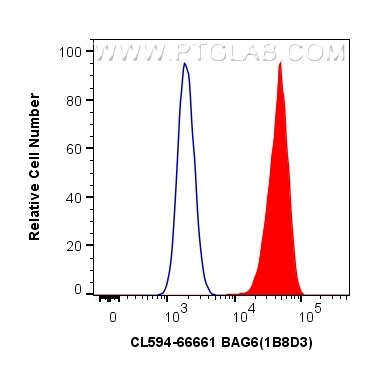- Phare
- Validé par KD/KO
Anticorps Monoclonal anti-BAG6
BAG6 Monoclonal Antibody for FC (Intra)
Hôte / Isotype
Mouse / IgG1
Réactivité testée
Humain, rat, souris
Applications
FC (Intra)
Conjugaison
CoraLite®594 Fluorescent Dye
CloneNo.
1B8D3
N° de cat : CL594-66661
Synonymes
Galerie de données de validation
Applications testées
| Résultats positifs en cytométrie | cellules HeLa |
Dilution recommandée
| Application | Dilution |
|---|---|
| Flow Cytometry (FC) | FC : 0.40 ug per 10^6 cells in a 100 µl suspension |
| It is recommended that this reagent should be titrated in each testing system to obtain optimal results. | |
| Sample-dependent, check data in validation data gallery | |
Informations sur le produit
CL594-66661 cible BAG6 dans les applications de FC (Intra) et montre une réactivité avec des échantillons Humain, rat, souris
| Réactivité | Humain, rat, souris |
| Hôte / Isotype | Mouse / IgG1 |
| Clonalité | Monoclonal |
| Type | Anticorps |
| Immunogène | BAG6 Protéine recombinante Ag24525 |
| Nom complet | HLA-B associated transcript 3 |
| Masse moléculaire calculée | 119 kDa |
| Poids moléculaire observé | 150-160 kDa |
| Numéro d’acquisition GenBank | BC003133 |
| Symbole du gène | BAT3 |
| Identification du gène (NCBI) | 7917 |
| Conjugaison | CoraLite®594 Fluorescent Dye |
| Excitation/Emission maxima wavelengths | 588 nm / 604 nm |
| Forme | Liquide |
| Méthode de purification | Purification par protéine G |
| Tampon de stockage | PBS avec glycérol à 50 %, Proclin300 à 0,05 % et BSA à 0,5 %, pH 7,3. |
| Conditions de stockage | Stocker à -20 °C. Éviter toute exposition à la lumière. Stable pendant un an après l'expédition. L'aliquotage n'est pas nécessaire pour le stockage à -20oC Les 20ul contiennent 0,1% de BSA. |
Informations générales
BAT3 also known as Scythe or BAG6, is a nuclear protein implicated in the control of apoptosis and natural killer (NK) cell-dendritic cell (DC) interaction. BAT3 was first discovered as a member of a group of genes located within the class III region of the human major histocompatibility complex on chromosome 6, and has been extensively studied for its role in regulating apoptosis under various stress conditions such as DNA damage and endoplasmic reticulum-related stress. BAT3 has been shown to be required for p53 acetylation, which is critical for the enhancement of p53 transcriptional activity in response to DNA damage. In addition, BAT3 is involved in the regulation of development and reproduction of mammals by acting as a co-chaperone of the heat shock protein HSP70.
Protocole
| Product Specific Protocols | |
|---|---|
| FC protocol for CL594 BAG6 antibody CL594-66661 | Download protocol |
| Standard Protocols | |
|---|---|
| Click here to view our Standard Protocols |


